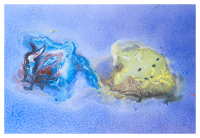Prof.
Adriano Natale
(UFABC/IFT-Unesp)
[Chiral transition of fundamental and adjoint quarks, published in Phys.Lett.B728, 626 (2014)][1]
[1]: http://www.sciencedirect.com/science/article/pii/S0370269313010174#
The chiral symmetry breaking transition of quarks in the fundamental and adjoint representation is
studied in a model where the gap equation contains two contributions, one containing a confining
propagator and another corresponding to the exchange of one-dressed dynamically massive gluons.
When quarks are in the fundamental representation the confinement effect dominates the chiral
symmetry breaking while the gluon exchange is suppressed due to the dynamical gluon mass effect
in the propagator and in the coupling constant. In this case the chiral and deconfinement transition
temperatures are approximately the same. For quarks in the adjoint representation, due to the larger
Casimir eigenvalue, the gluon exchange is operative and the chiral transition happens at a larger
temperature than the deconfinement one
Summary
The chiral symmetry breaking transition of quarks in the fundamental and adjoint representation is
studied in a model where the gap equation contains two contributions, one containing a confining
propagator and another corresponding to the exchange of one-dressed dynamically massive gluons.
When quarks are in the fundamental representation the confinement effect dominates the chiral
symmetry breaking while the gluon exchange is suppressed due to the dynamical gluon mass effect
in the propagator and in the coupling constant. In this case the chiral and deconfinement transition
temperatures are approximately the same. For quarks in the adjoint representation, due to the larger
Casimir eigenvalue, the gluon exchange is operative and the chiral transition happens at a larger
temperature than the deconfinement one
